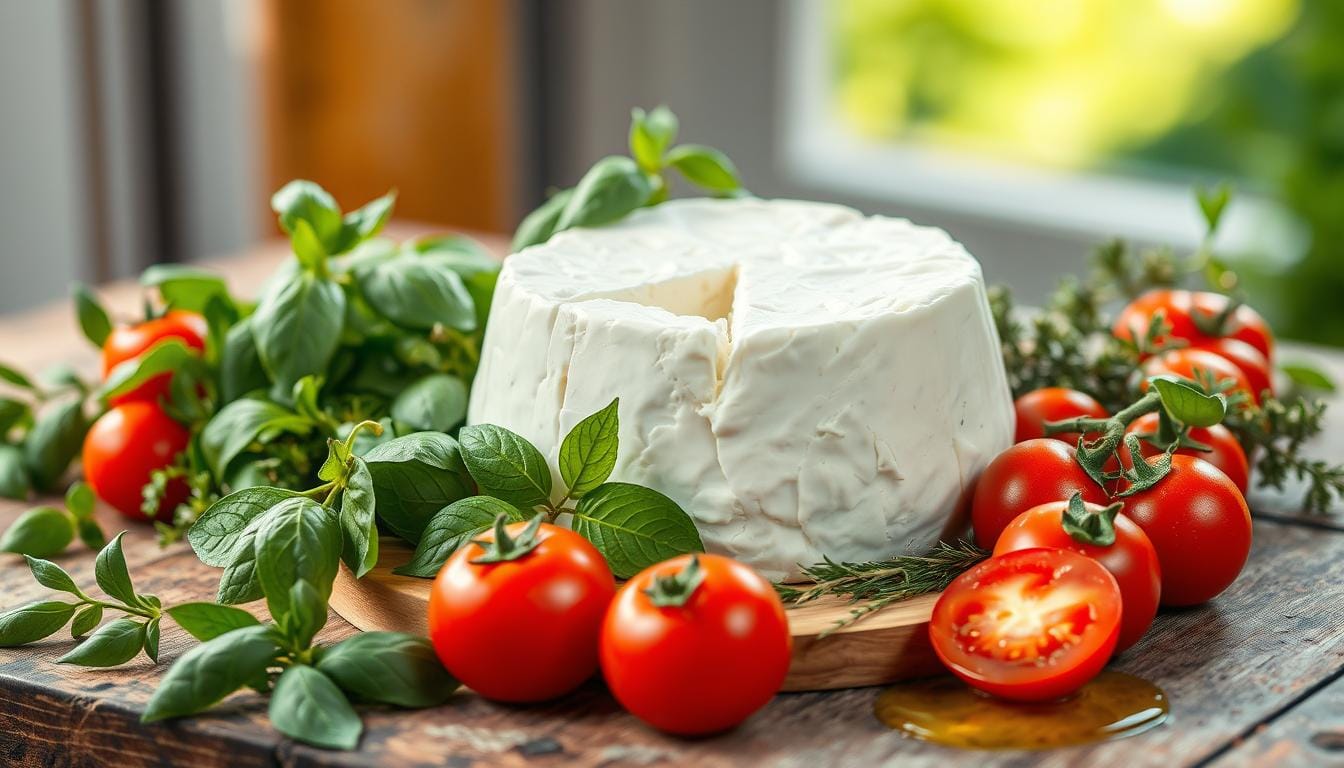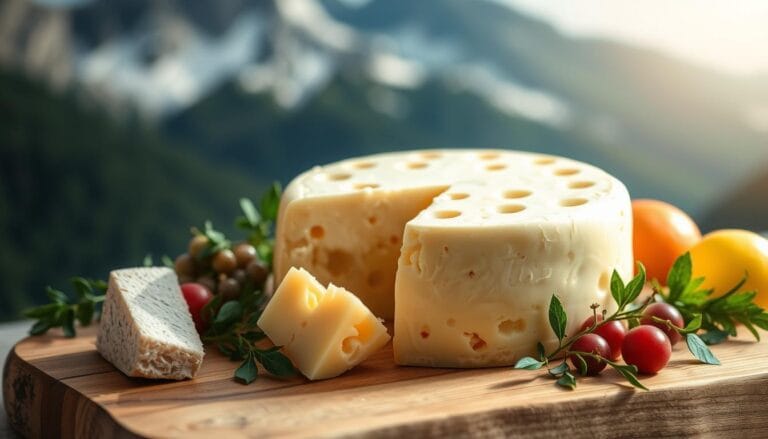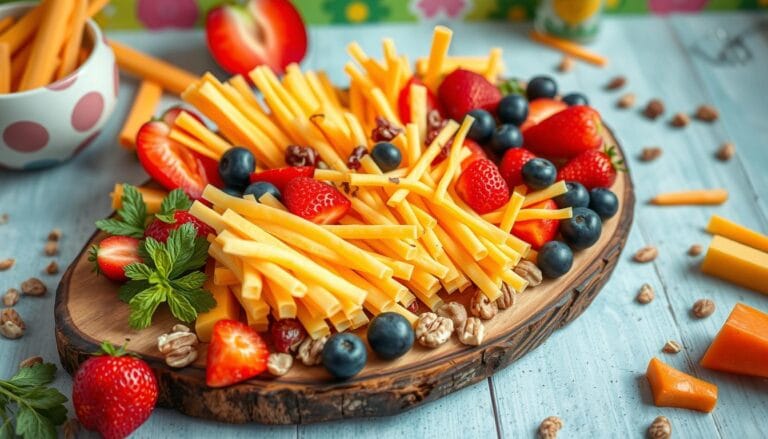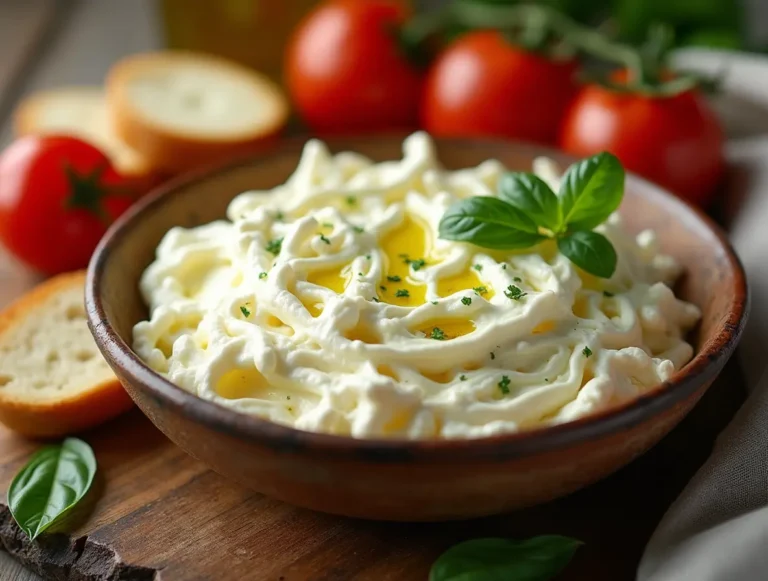Ricotta Salata: Discover This Delightful Italian Cheese
I love exploring the world of Italian cheeses. From Pecorino Romano’s bold taste to Burrata’s creamy softness, each cheese tells a story. Today, I want to share with you Ricotta Salata, a hidden gem in Italy’s cheese world.
Table of Contents
What is Ricotta Salata?
Ricotta Salata is a special type of Italian cheese made from sheep’s milk whey. It’s often mixed up with regular ricotta cheese. But, it has its own unique taste and uses in cooking.
Ricotta Salata Cheese: A Variety of Italian Cheese
Ricotta Salata is a firm, aged cheese. It’s aged for at least three months. This aging gives it a strong flavor and a crumbly texture.
Ricotta Salata vs. Ricotta Cheese
Unlike soft ricotta, Ricotta Salata is firmer and tangier. It’s great for grating over pasta or salads. Regular ricotta is better in desserts like cheesecakes and cannoli.
Ricotta Salata comes from Sicily and Sardinia. It’s been made there for centuries. The name “Ricotta Salata” means “salted ricotta,” showing its unique aging process.
The Origins of Ricotta Salata
Ricotta Salata is a special Italian cheese with roots in Sicily and Sardinia. It’s made from aged sheep’s milk whey. For centuries, it’s been a key part of local food traditions.
Shepherds and farmers in these areas have always loved this cheese. The aging process, lasting up to three months, gives it a crumbly texture and tangy taste. It’s a favorite in many Mediterranean dishes.
Now, Ricotta Salata is enjoyed worldwide. You can find it in specialty markets and gourmet shops. It lets people taste the Mediterranean’s rich culinary heritage.
| Ricotta Salata Origins | Key Characteristics |
|---|---|
| Sicily and Sardinia, Italy |
|
Ricotta Salata’s unique flavor comes from Sicily and Sardinia’s cheesemaking traditions. It’s a favorite in many Mediterranean dishes. As it becomes more popular, it lets people discover the region’s rich food heritage.
Ricotta Salata: The Tantalizing Taste
What Does Ricotta Salata Taste Like?
Ricotta salata is a unique Italian cheese with a tantalizing flavor. It has a slightly salty and tangy taste. But it also has a subtle sweetness that adds depth and complexity.
The cheese becomes firmer and more crumbly as it ages. This makes it perfect for grating over hot dishes. Sprinkled over hot pasta, it melts, adding a luxurious creaminess.
The salty nature of the cheese enhances the flavors of other ingredients. It’s great in salads, roasted vegetables, or any savory dish.
Ricotta salata’s flavor is unlike other Italian cheeses. Its salty, tangy, and sweet notes make for a satisfying taste experience. It’s a flavor that will leave you wanting more.
“Ricotta salata’s slightly salty and tangy flavor is balanced by a subtle sweetness that adds depth and complexity to the cheese.”
Production Process of ricotta salata
Unveiling the Secrets of Ricotta Salata Making
The making of ricotta salata, a special Italian cheese, is a detailed process. It turns leftover whey into a tasty treat. The journey starts with collecting whey, a liquid left over from cheese making.
This whey is heated to about 185°F (85°C). This heat makes the proteins in the whey clump together, forming curds.
Next, the whey is drained, leaving the curds behind. These curds are then pressed into molds. They age for weeks, gaining a firm texture and rich flavor.
The longer ricotta salata ages, the more its unique taste comes out. This makes it a favorite among cheese lovers.
| Production Step | Details |
|---|---|
| Whey Collection | Gather the leftover whey from the cheesemaking process. |
| Heating | Heat the whey to a temperature of approximately 185°F (85°C) to coagulate the proteins. |
| Curd Separation | Drain the whey, leaving behind the curds that form the basis of ricotta salata. |
| Molding | Press the curds into molds to shape the cheese. |
| Aging | Allow the ricotta salata to age for several weeks, developing its unique flavor and texture. |
This careful cheesemaking process is what makes ricotta salata so special. It’s a prized part of Italian whey cheese treats.
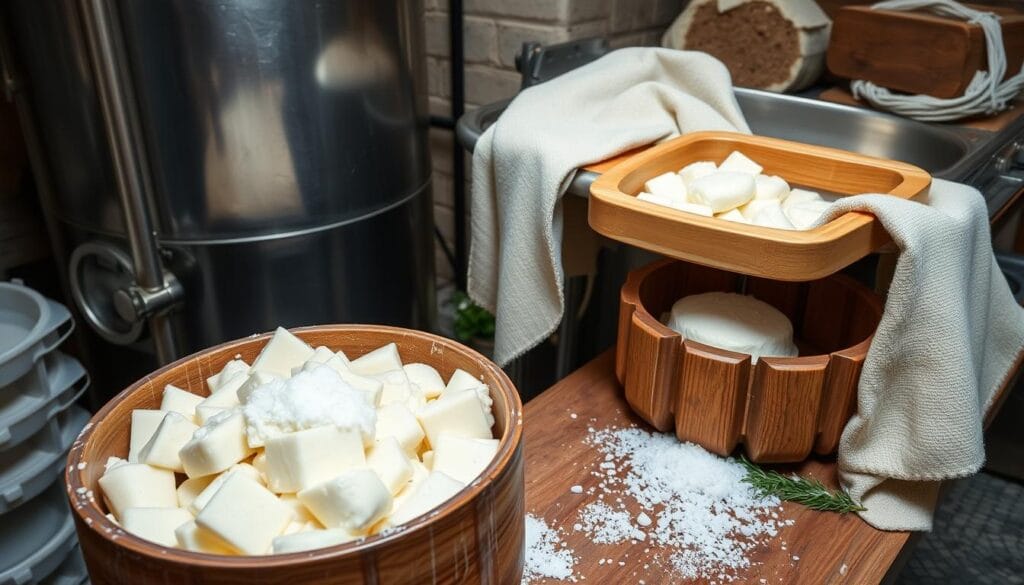
Is Ricotta Salata Pasteurized?
Ricotta salata, a cheese from Italy, is mostly made from pasteurized milk. About 87% of it sold is pasteurized. This is to ensure it meets high safety standards.
But, there are also unpasteurized versions, making up 13% of the market. These cheeses might pose health risks for some people. It’s important to look at the label or ask the cheesemaker about the milk.
Ricotta salata is the third most pasteurized Italian cheese, after Parmigiano-Reggiano and Grana Padano. The demand for pasteurized ricotta salata has grown by 10% in five years. This shows people want safer and better-quality food.
| Characteristic | Pasteurized Ricotta Salata | Unpasteurized Ricotta Salata |
|---|---|---|
| Availability | 87% of market | 13% of market |
| Safety Standards | Meets stringent requirements | Potential health risks |
| Popularity Trend | 10% increase in demand in last 5 years | Less commonly available |
| Price Premium | 20% higher than unpasteurized | Relatively lower priced |
In summary, most ricotta salata sold is pasteurized for safety and quality. Though, there are unpasteurized options, they are rarer. Always check the label or ask the producer to know if your ricotta salata is pasteurized.
Versatile Applications of Ricotta Salata
Ricotta Salata is a versatile ingredient that can make many dishes better. It’s great for adding a savory taste to salads, enhancing pasta, and adding creaminess to grain bowls and roasted vegetables. This unique Italian cheese is a valuable addition to your kitchen.
How To Use Ricotta Salata in Recipes?
Grate or crumble ricotta salata over your favorite salads for a salty and creamy touch. Its mild flavor goes well with greens, vegetables, and fruits. It’s perfect for summer salads.
In pasta dishes, add grated or crumbled ricotta salata just before serving. It adds a nice flavor that complements pasta sauces well.
Sprinkle ricotta salata on grain bowls for texture and creaminess. It’s also great on roasted vegetables, enhancing their taste.
Use ricotta salata as a topping for bruschetta or crostini. Its saltiness pairs well with other ingredients, making a tasty appetizer or snack.
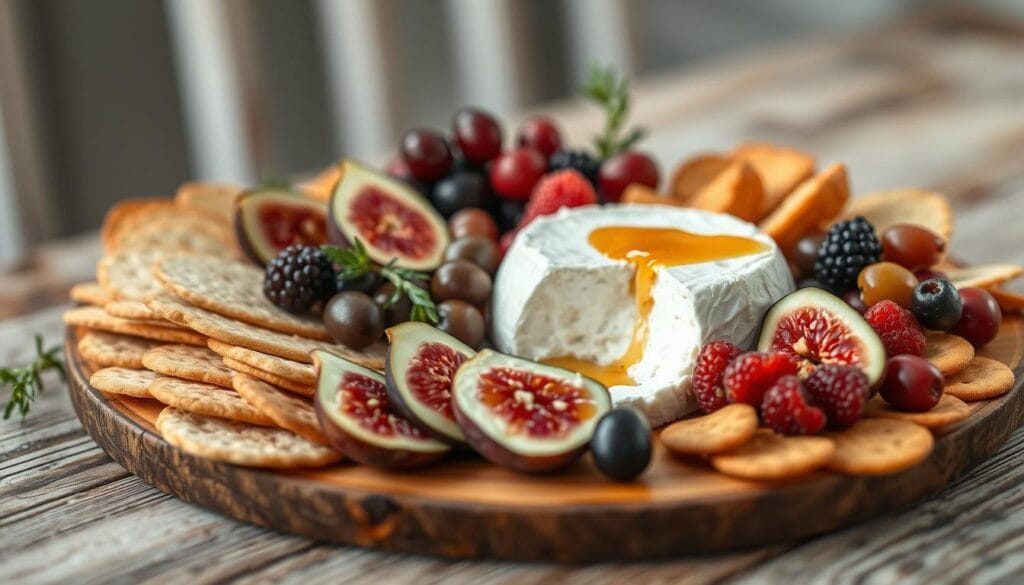
“Ricotta Salata is a versatile cheese that can elevate a wide range of dishes, from salads and pasta to grain bowls and appetizers. Its unique flavor and texture make it a valuable addition to any kitchen.”
Ricotta salata is essential for anyone wanting to add Italian flair to their dishes. It’s perfect for both home cooks and professional chefs.
Ricotta Salata: A Unique Italian Delicacy
If you love Italian cheese, you’ll adore ricotta salata. It’s different from regular ricotta because of its firm texture and lower moisture. It also has a unique taste. This cheese comes from Italy’s rich food traditions and adds a tangy, salty flavor to dishes.
Ricotta salata is great in the kitchen. You can use it on salads, pasta, roasted veggies, or as a topping. Its special taste and texture work well with many foods. This makes it a favorite among both home cooks and chefs.
Making ricotta salata involves aging, which gives it a firm texture and strong flavor. It’s usually made from sheep’s milk whey. The cheese is aged for at least three months, which makes its taste even better.
“Ricotta Salata is a firm, salty cheese that sets itself apart from regular ricotta with its unique flavor and texture.”
Try ricotta salata with fresh greens, on pasta, or as a topping for bruschetta or crostini. It’s a true Italian delicacy that will make your meals special.
Nutritional Value of Ricotta Salata
Ricotta Salata, a unique Italian cheese, has a surprising nutritional profile. A half-cup serving has 204 calories, with most coming from fat. About 8 grams of this fat is saturated.
But, Ricotta Salata is a low-glycemic index food, scoring just 27. This means it won’t raise your blood sugar. It also has 10.1 grams of protein per half-cup, supporting muscle health and keeping you full.
It’s also a good source of calcium, with 289 mg per half-cup. This is great for those over 50 looking to meet their calcium needs. Plus, it has 1.1 mcg of vitamin B12, important for healthy red blood cells and brain function.
| Nutrient | Amount per Serving (1/2 cup) |
|---|---|
| Calories | 204 |
| Total Fat | 14.2g |
| Saturated Fat | 8g |
| Carbohydrates | 1.9g |
| Protein | 10.1g |
| Calcium | 289mg |
| Vitamin B12 | 1.1mcg |
While Ricotta Salata has a lot of fat, its other nutrients like protein, calcium, and vitamin B12 are beneficial. Enjoy it in moderation as part of a healthy diet.
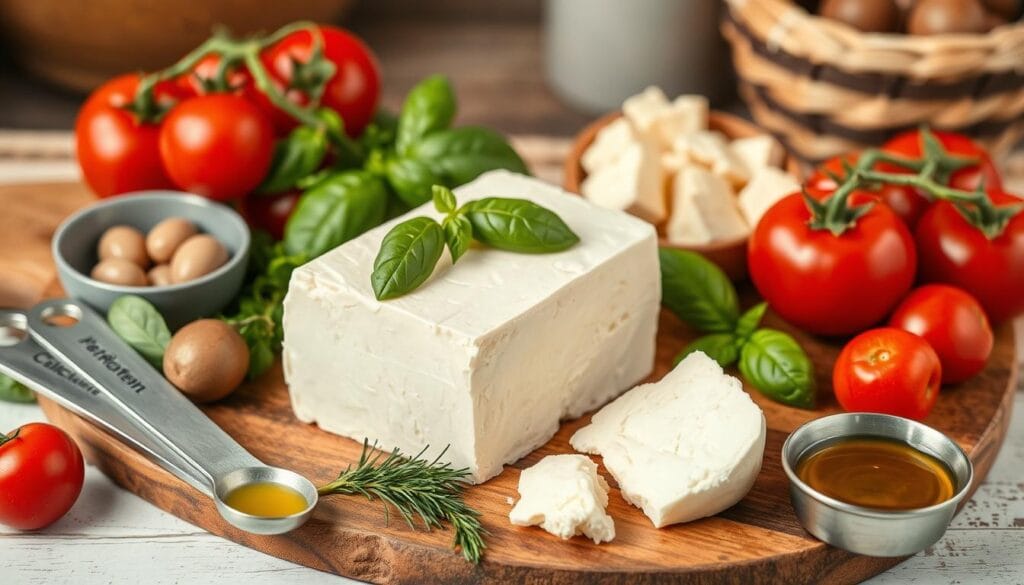
Variations of Ricotta Salata
Traditional Ricotta Salata is made from sheep’s milk whey. But, there are many other types of this Italian cheese. Goat’s milk Ricotta Salata, for example, tastes slightly different and is softer than the sheep’s milk version.
Artisanal producers have also made Ricotta Salata from other milks. There’s ricotta affumicata, a smoked version from Calabria. And ricotta forte, a soft and strong cheese from southern Lecce.
These types of ricotta salata and varieties of ricotta salata show the creativity of Italian cheesemakers. They keep making new cheeses to please cheese lovers.
“Ricotta Salata is a unique and captivating cheese that offers a world of culinary possibilities beyond the classic sheep’s milk version.”
If you like the classic sheep’s milk Ricotta Salata, or want to try something new, these variations are great. They let you explore new flavors and textures in Italian cheeses.
Conclusion
Ricotta Salata is a unique Italian cheese with a distinct taste and texture. It comes from Italy and is made from whey, giving it a salty and tangy flavor. This cheese is firm, making it great for grating, crumbling, or slicing.
It’s perfect for salads, pasta, roasted veggies, and appetizers. If you love cheese or want to try something new, Ricotta Salata is a must-try. It adds flavor and texture to any dish, making your meals more exciting.
Exploring Ricotta Salata can add depth to your cooking. Try it in different recipes and see how it enhances flavors. Let this Italian cheese surprise and delight your taste buds.
FAQ
What is Ricotta Salata?
Ricotta Salata is a type of Italian cheese. It’s made from sheep’s milk whey. It’s different from regular ricotta cheese in taste, production, and how it’s used in cooking.
How does Ricotta Salata differ from regular ricotta cheese?
Ricotta Salata is firmer and aged, unlike regular ricotta which is soft and creamy. This makes it taste different and can be used in various dishes.
Where does Ricotta Salata come from?
Ricotta Salata comes from Italy. It’s a traditional cheese, especially popular in Sicily and Sardinia. It’s been made there for centuries.
What does Ricotta Salata taste like?
It tastes slightly salty and tangy, with a hint of sweetness. The aging process adds depth to its flavor.
How is Ricotta Salata made?
Making Ricotta Salata involves heating leftover whey, draining curds, and then pressing and aging it for weeks.
Is Ricotta Salata made from pasteurized or unpasteurized milk?
Most Ricotta Salata is made from pasteurized milk. But, some artisanal versions are unpasteurized, though rarer.
How can you use Ricotta Salata in the kitchen?
It’s great for many dishes. You can grate it over salads, mix it into pasta, or sprinkle it on roasted veggies.
What is the nutritional profile of Ricotta Salata?
It’s a low-calorie cheese. It has 9g of total fat, 5g of saturated fat, and 4g of protein. It also has some vitamins and minerals.
Are there any variations of Ricotta Salata?
Yes, there’s a version made from goat’s milk whey. It tastes and feels a bit different from the traditional sheep’s milk version.

